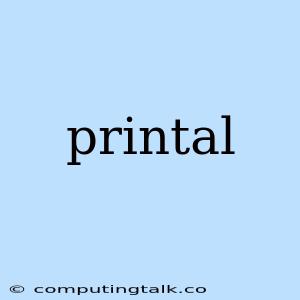Printal: A Comprehensive Guide to Printing in Today's Digital Age
The world of printing has evolved significantly, moving beyond simple paper documents to a realm of sophisticated technologies and diverse applications. Printal encompasses the entire spectrum of printing processes, from the traditional offset printing to the cutting-edge 3D printing, catering to a vast range of needs.
What is Printal?
Printal is a broad term encompassing all forms of printing technologies and their applications. It involves the transfer of images, text, or designs onto various surfaces using ink, toner, or other materials. It plays a crucial role in several industries, including:
- Publishing: Books, magazines, newspapers, and other printed materials.
- Advertising: Brochures, flyers, posters, and other promotional materials.
- Packaging: Boxes, labels, and other product packaging.
- Textiles: T-shirts, fabrics, and other textile printing.
- Construction: Building plans, blueprints, and other architectural documents.
- Art & Design: Artwork, posters, and other creative applications.
Types of Printal Technologies:
Printal encompasses numerous printing methods, each with unique capabilities and applications:
- Offset Printing: A traditional method using plates to transfer ink onto a rubber blanket and then onto the paper. It is widely used for high-volume print jobs like books and magazines.
- Digital Printing: A modern method using digital files to directly transfer images onto paper, offering flexibility and speed. It is ideal for short-run print jobs, personalized items, and on-demand printing.
- Screen Printing: A technique using stencils to transfer ink onto fabric or other surfaces. It is widely used for t-shirts, posters, and signage.
- 3D Printing: An innovative technology that builds three-dimensional objects layer by layer using a digital design. It offers endless possibilities in design, prototyping, and manufacturing.
- Flexographic Printing: A rotary printing method using flexible plates for packaging and labels.
- Gravure Printing: A high-quality printing method using engraved cylinders for magazines and packaging.
Choosing the Right Printal Method:
The selection of the appropriate printal method depends on various factors, including:
- Quantity: Large print runs usually require offset printing, while digital printing is suitable for small quantities.
- Budget: Offset printing is cost-effective for large quantities, while digital printing offers flexibility and affordability for smaller jobs.
- Material: Different printal methods are compatible with various materials, such as paper, fabric, plastic, and metal.
- Quality: Offset printing typically offers higher quality than digital printing, but digital printing has made significant advancements in resolution and detail.
Tips for Effective Printal:
- Define your purpose: Clearly identify the objective of the print job, whether it's for marketing, branding, or functional purposes.
- Choose the right printal method: Consider the quantity, budget, and quality requirements to select the optimal printing method.
- Prepare high-quality files: Ensure your images and designs are in the correct file format and resolution for the chosen printal method.
- Proofread carefully: Review your print files thoroughly to eliminate errors before printing.
- Select the appropriate paper or substrate: Choose the right paper or material based on the intended use and desired effect.
- Consider finishing options: Explore finishing options such as binding, laminating, and embossing to enhance the presentation of your print materials.
Printal in the Future:
The future of printal is promising, driven by technological advancements and evolving consumer needs. We can expect further innovations in:
- Sustainable printing: Using eco-friendly inks and materials to minimize environmental impact.
- Personalized printing: Creating customized printed materials for individual preferences.
- Augmented reality printing: Combining print with interactive digital content.
- 3D printing applications: Expanding the use of 3D printing in various industries and applications.
Conclusion:
Printal remains an essential aspect of our digital age, offering a diverse range of printing technologies and applications to cater to various needs. Understanding the different printal methods, their advantages, and limitations is crucial for making informed decisions about your printing projects. As technology continues to evolve, we can expect printal to play an increasingly important role in shaping our world.
